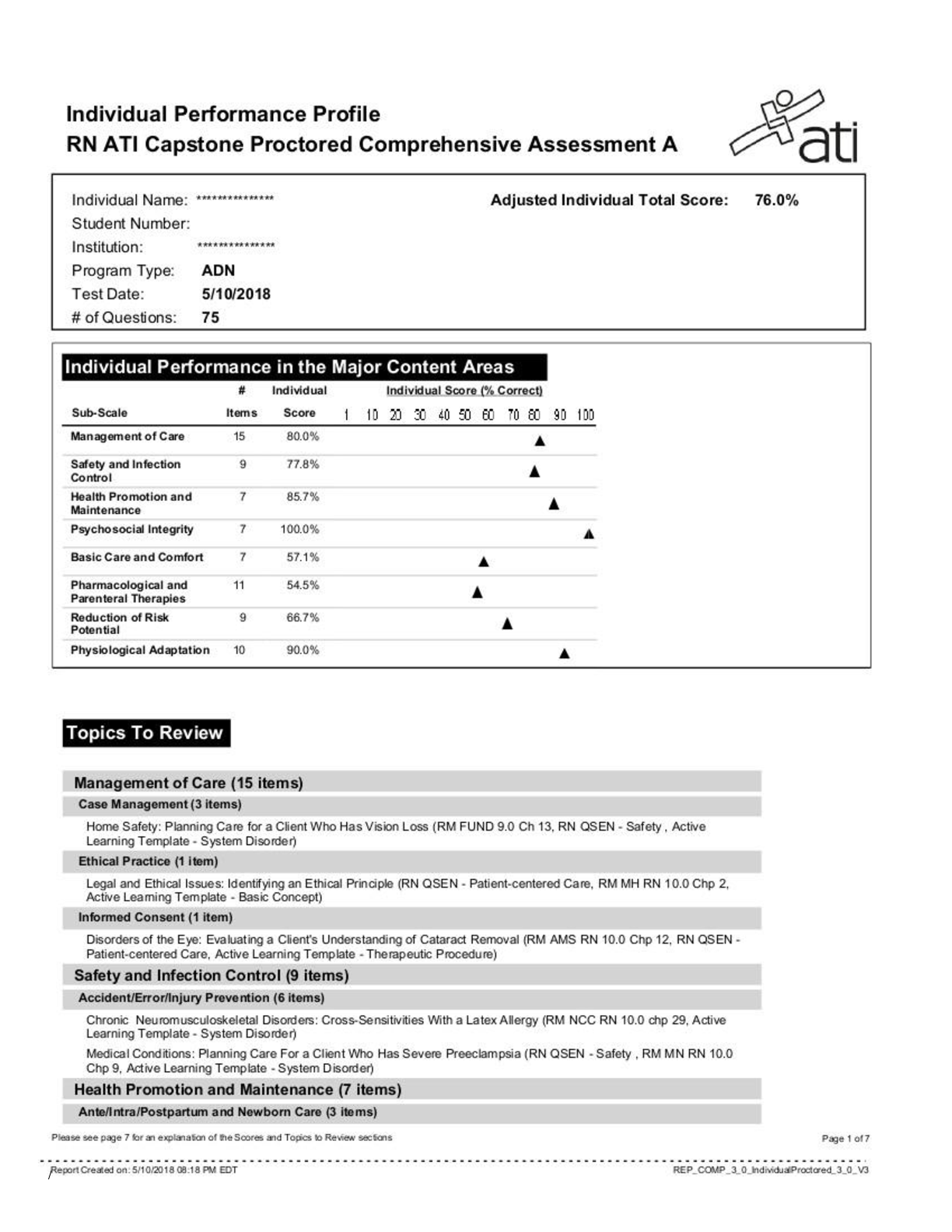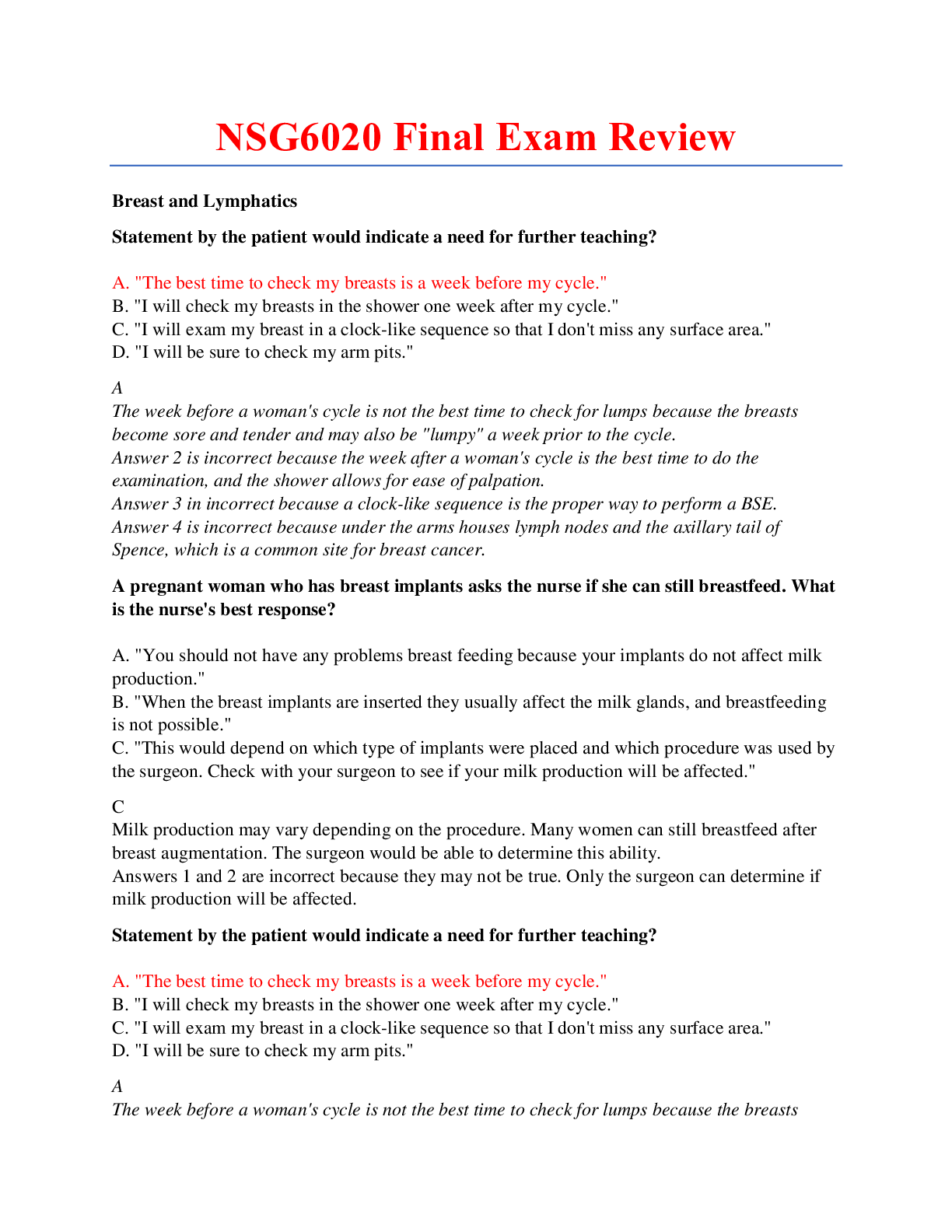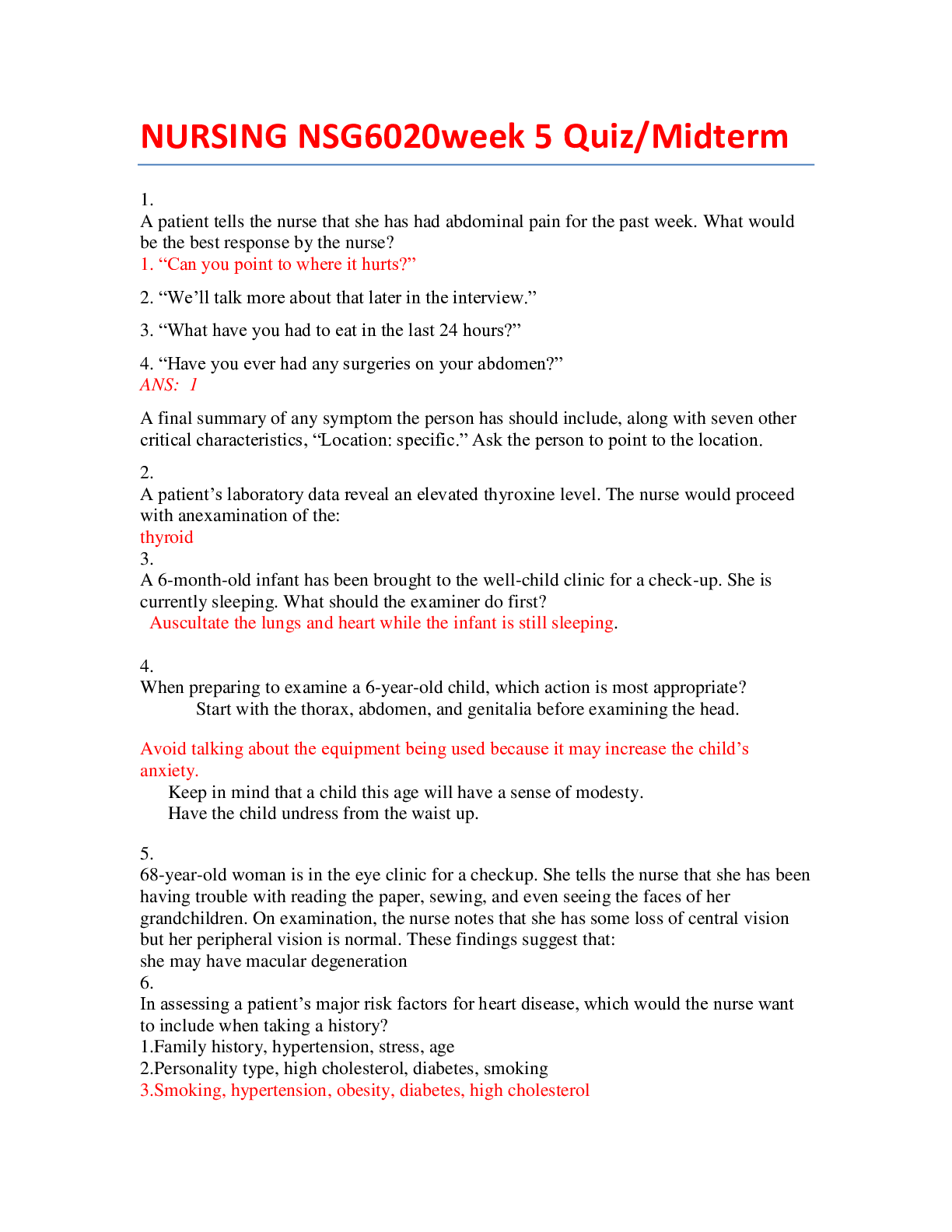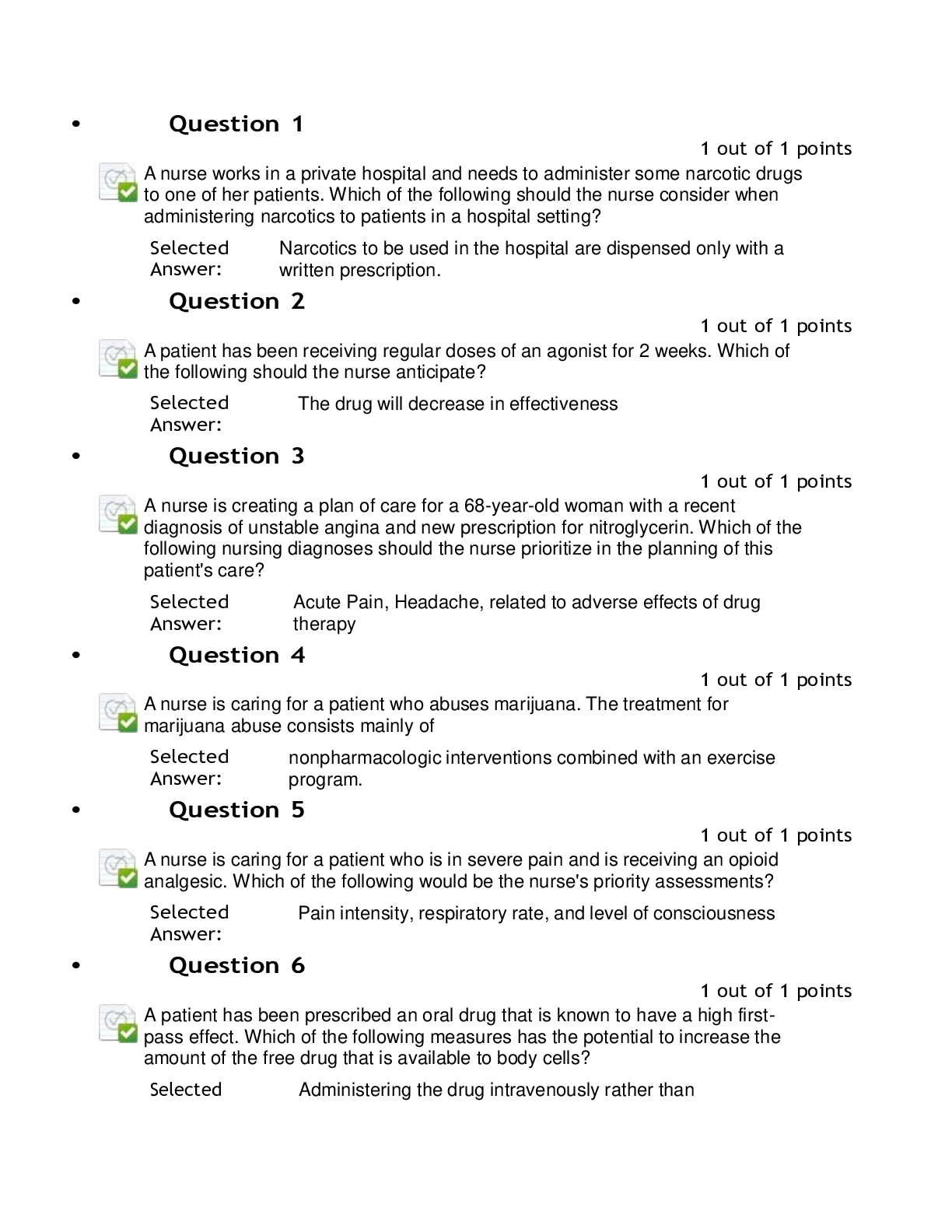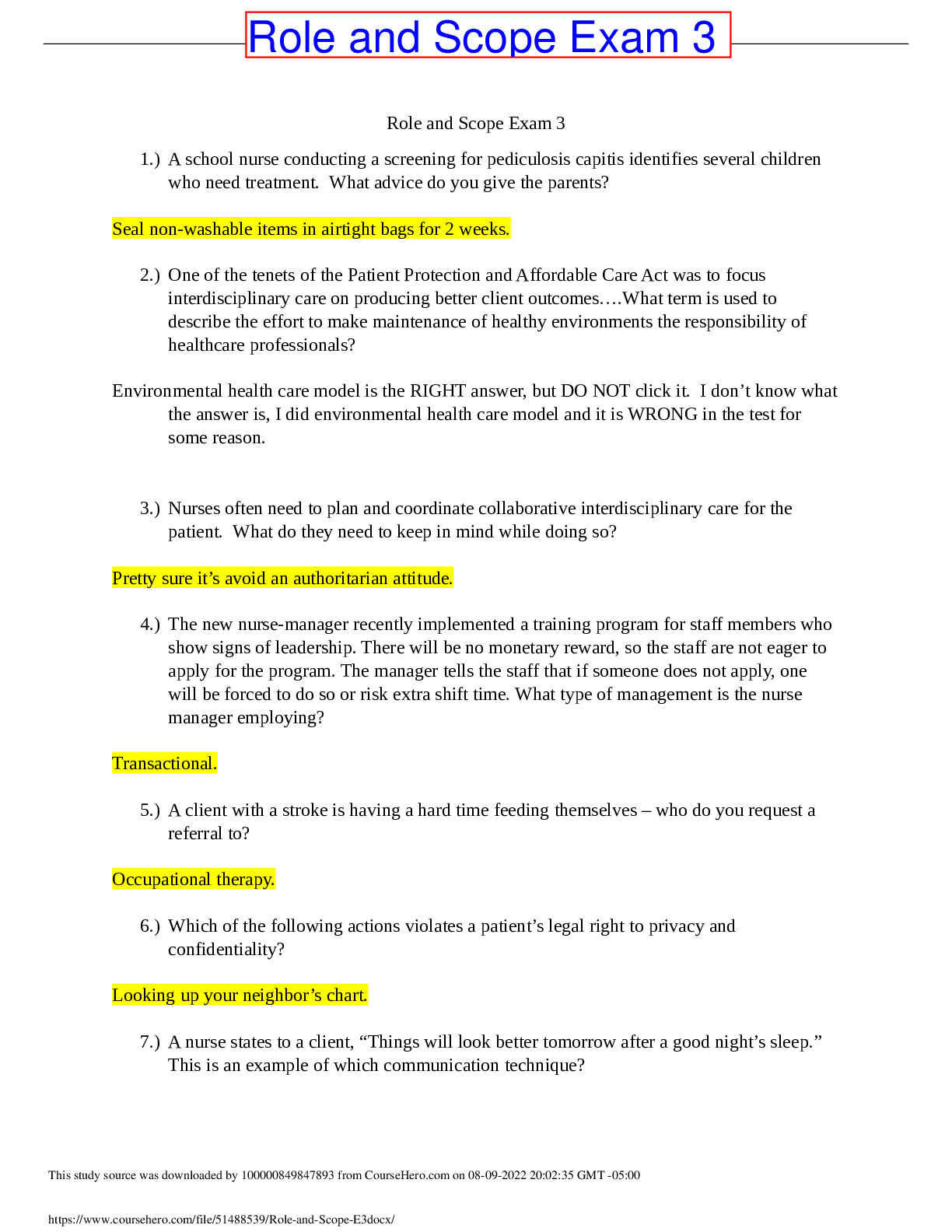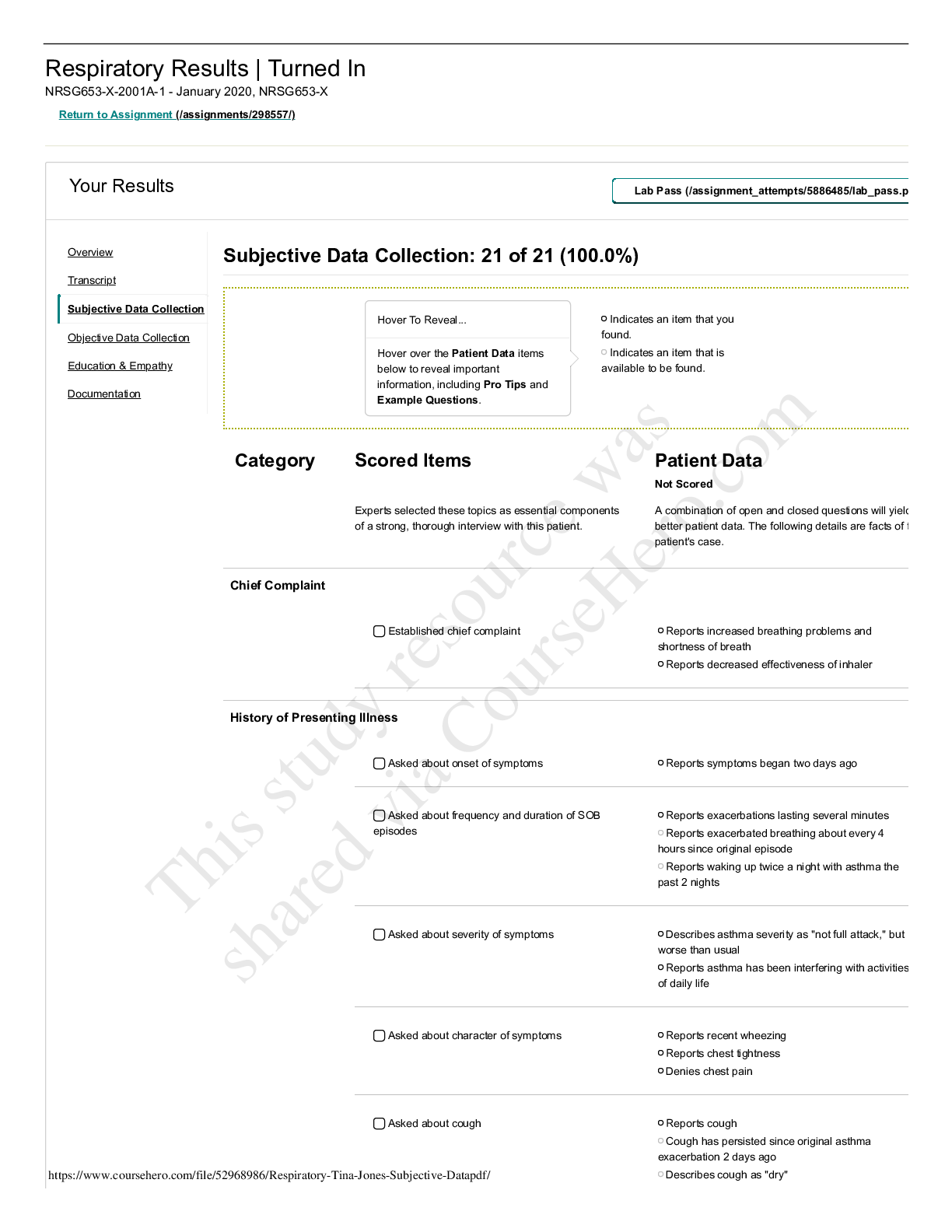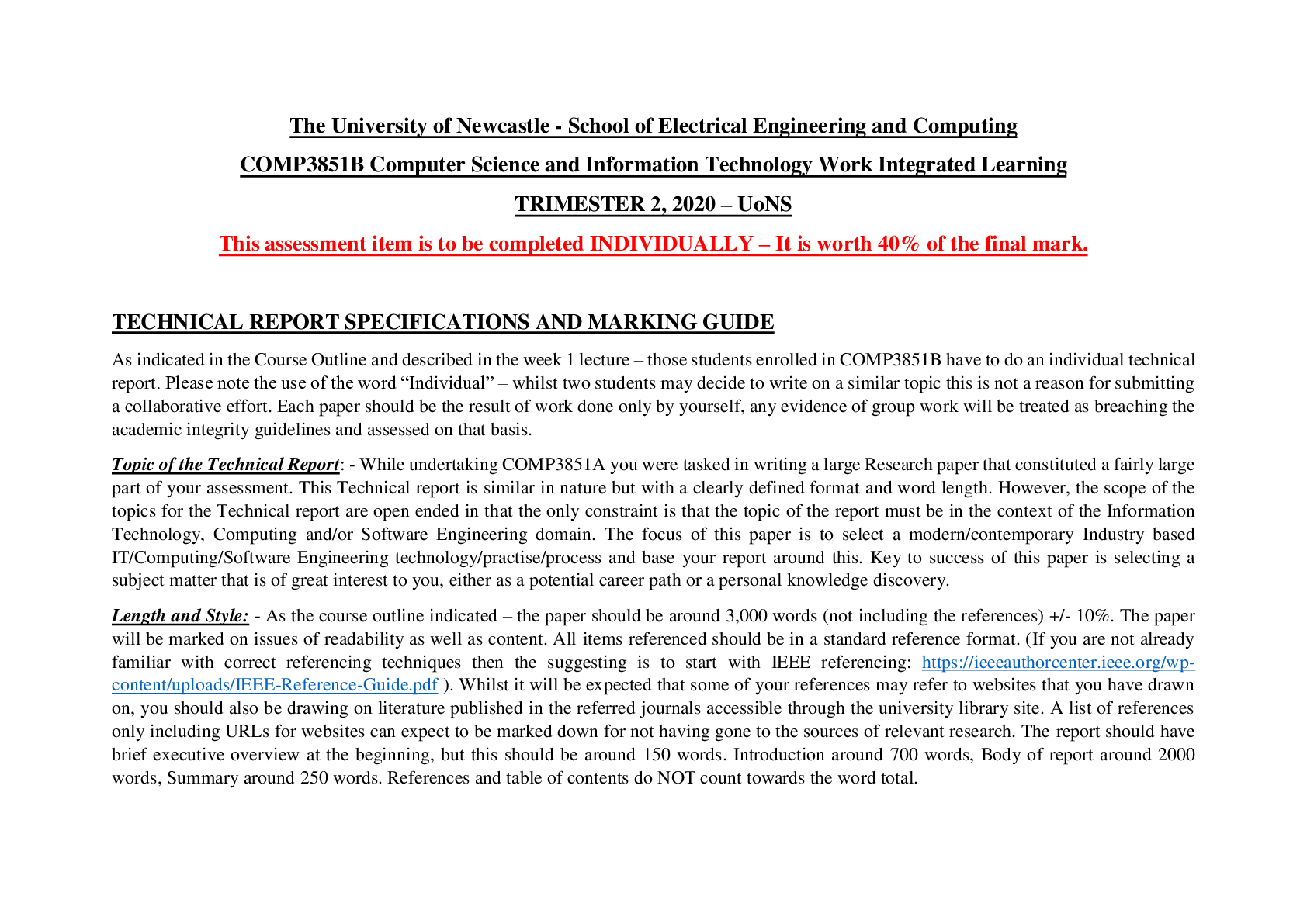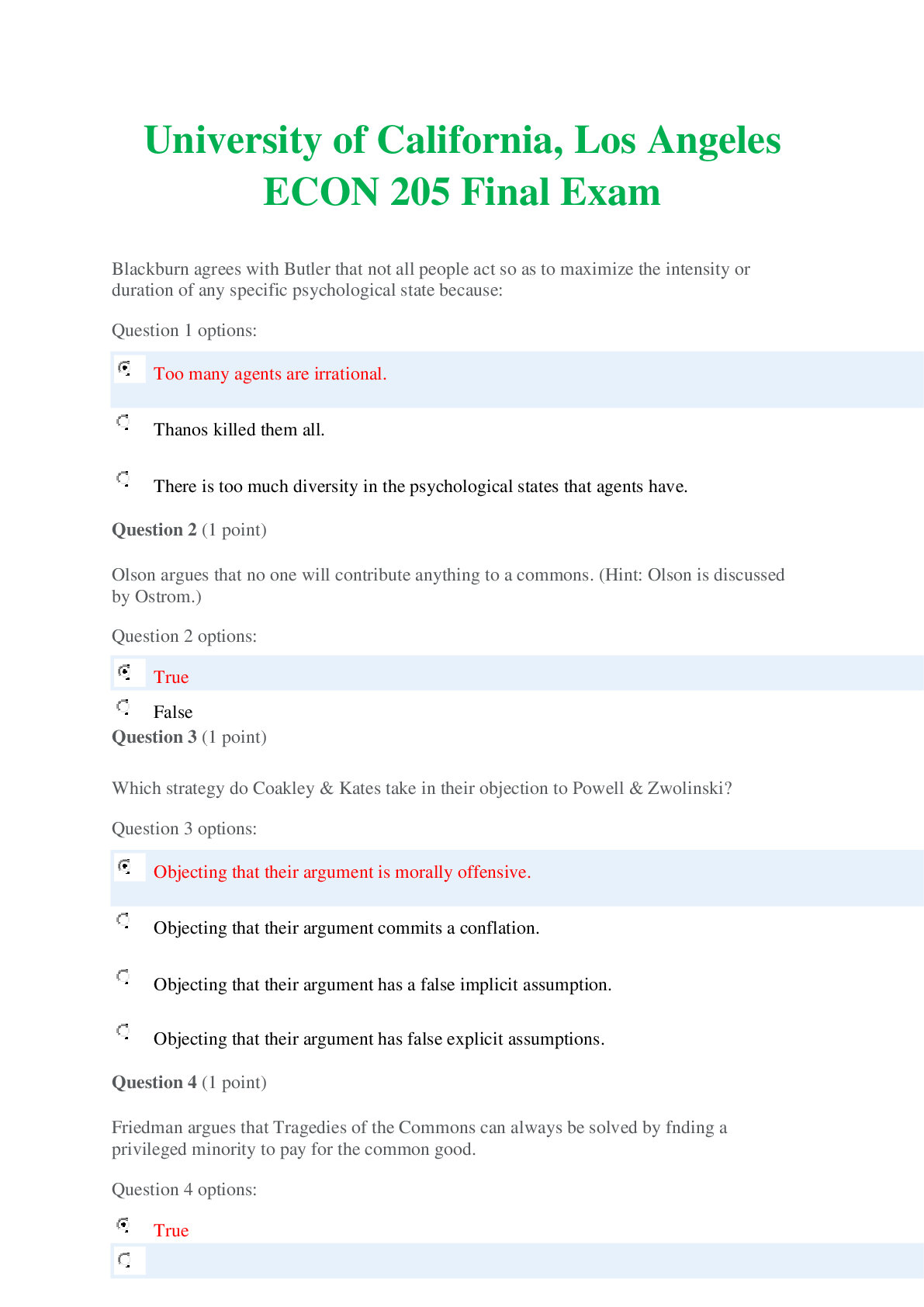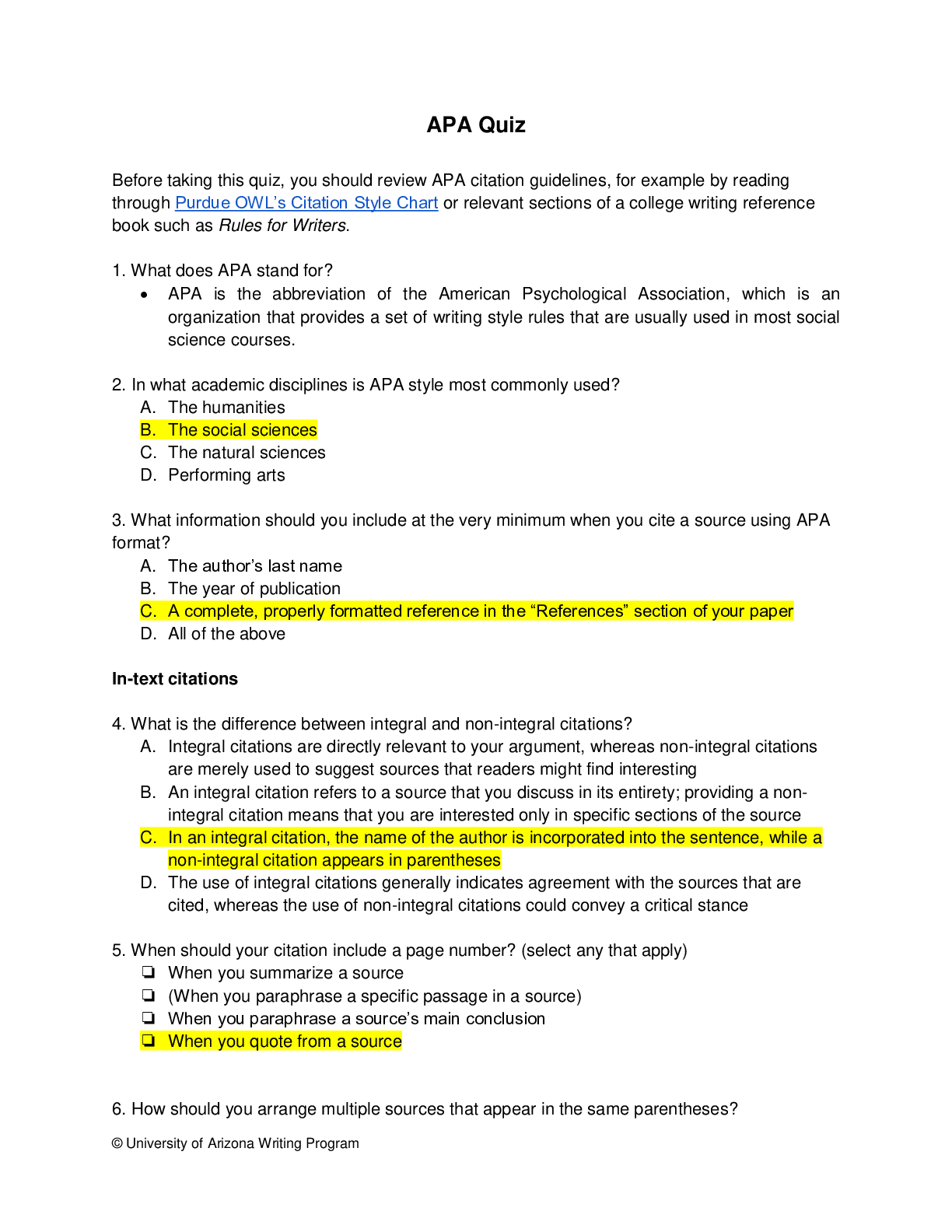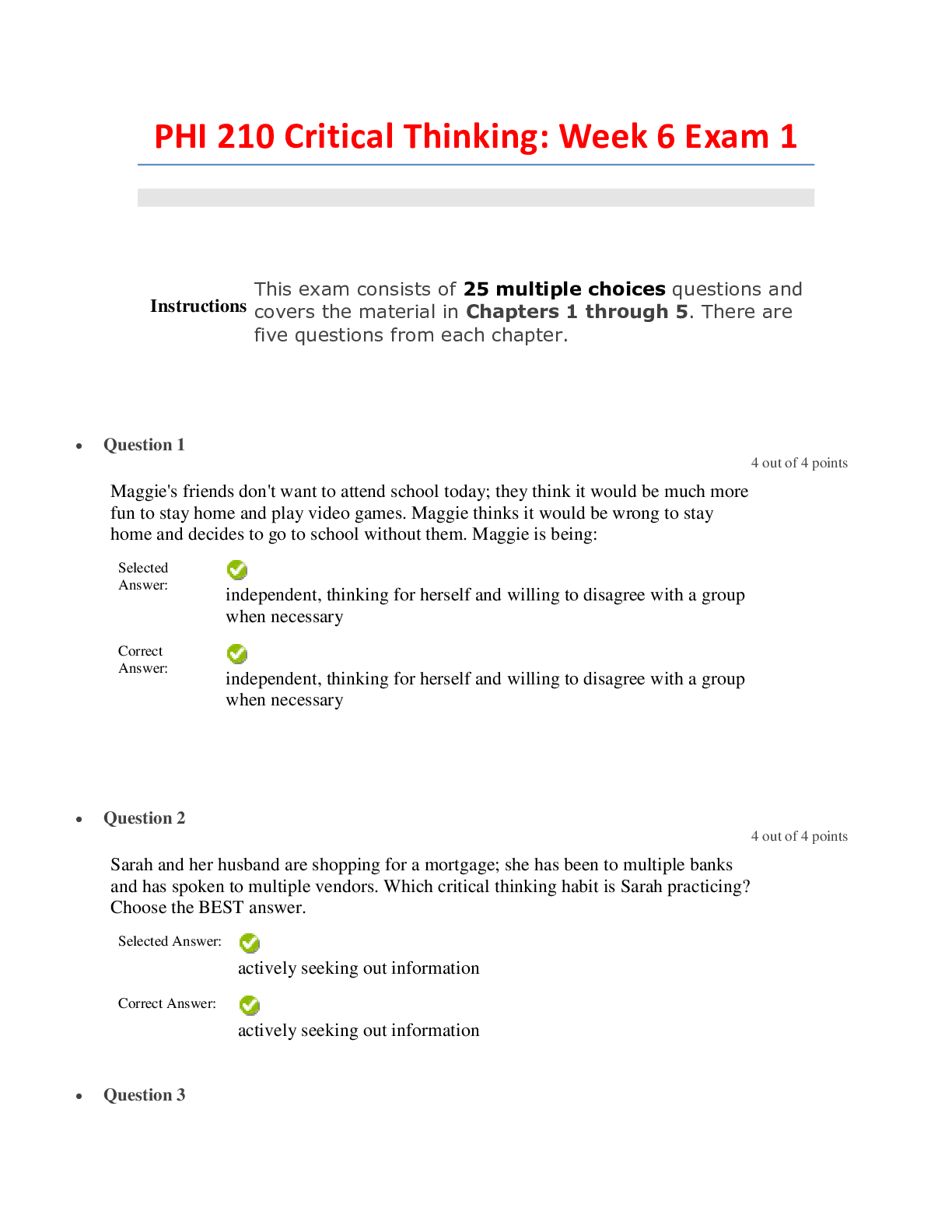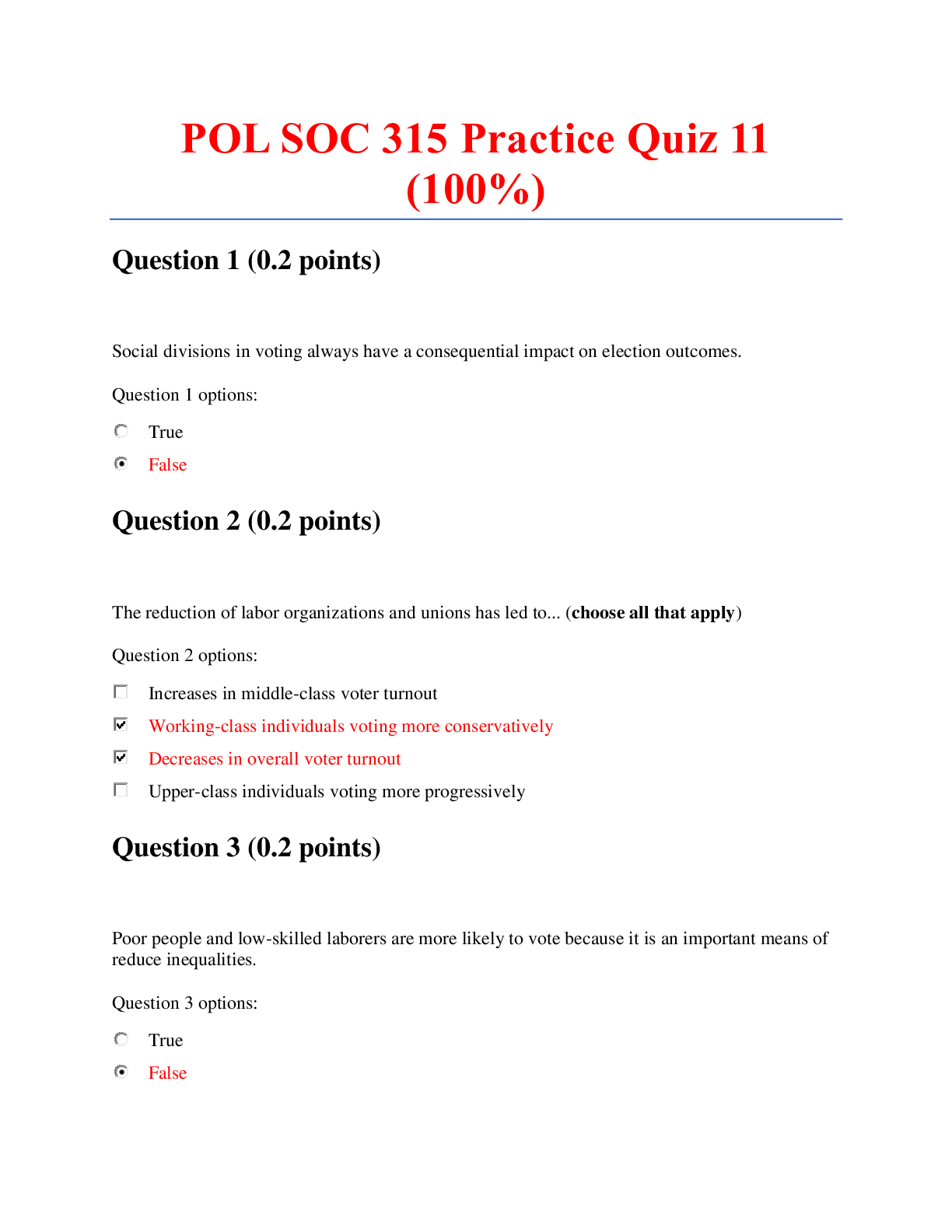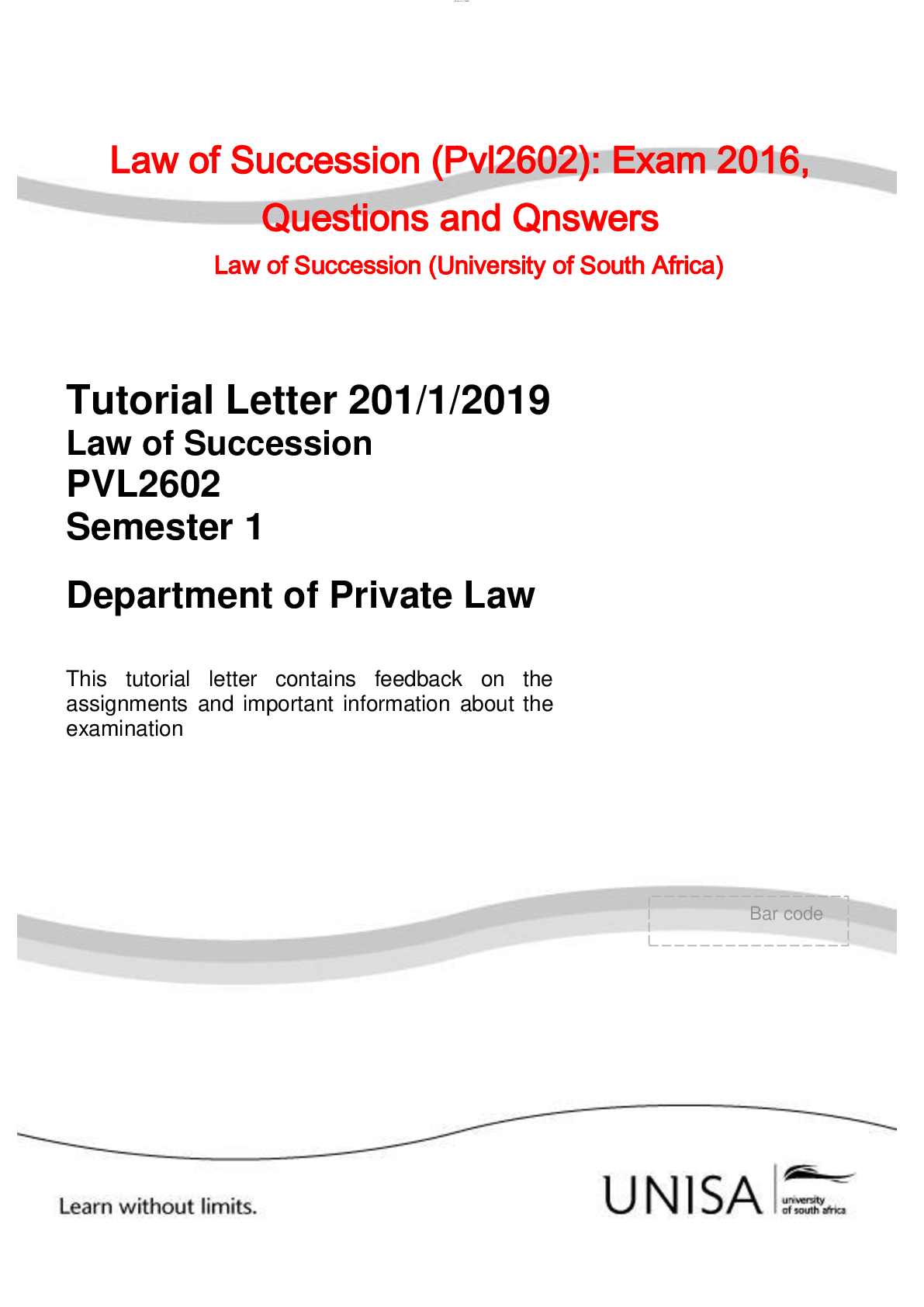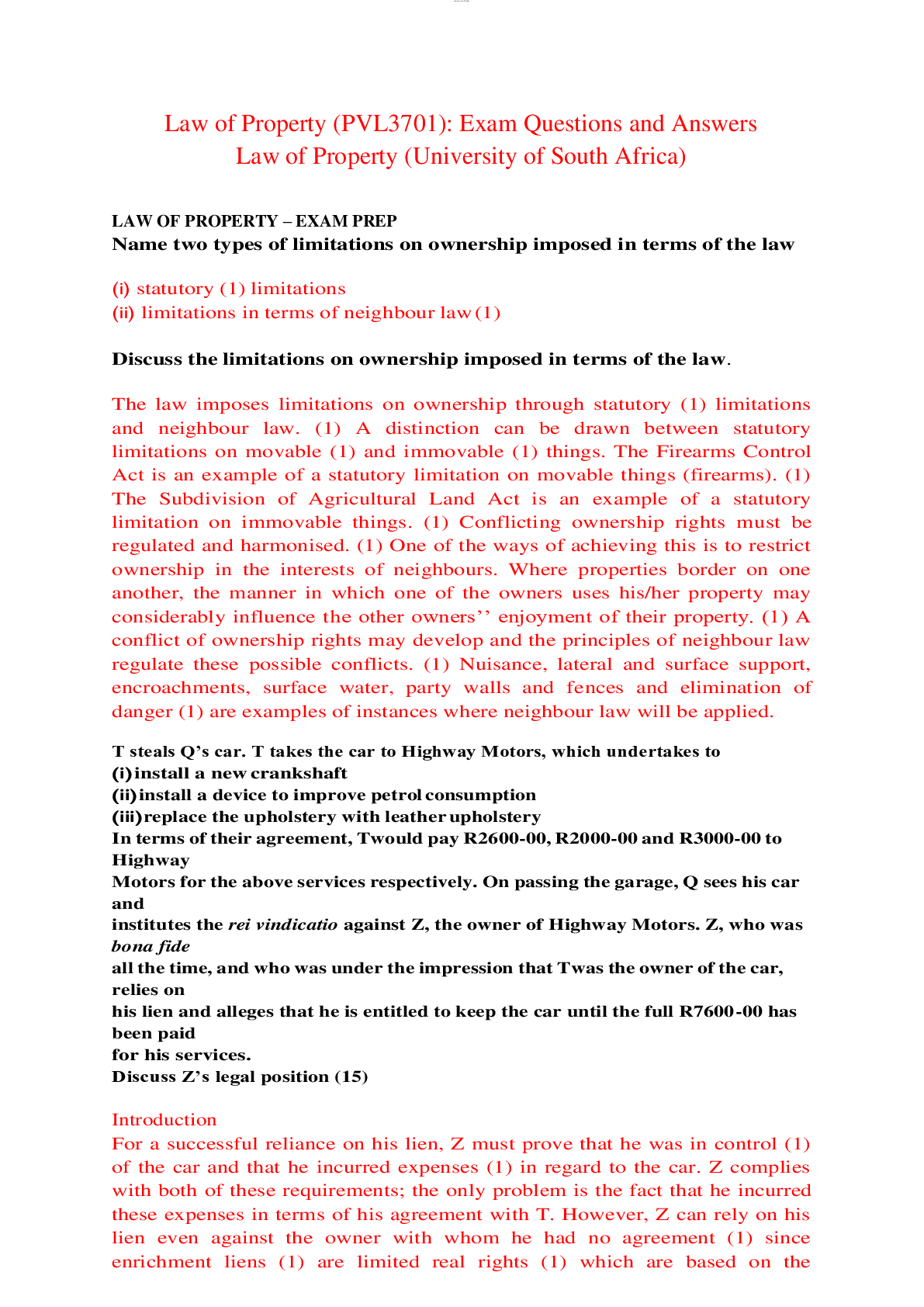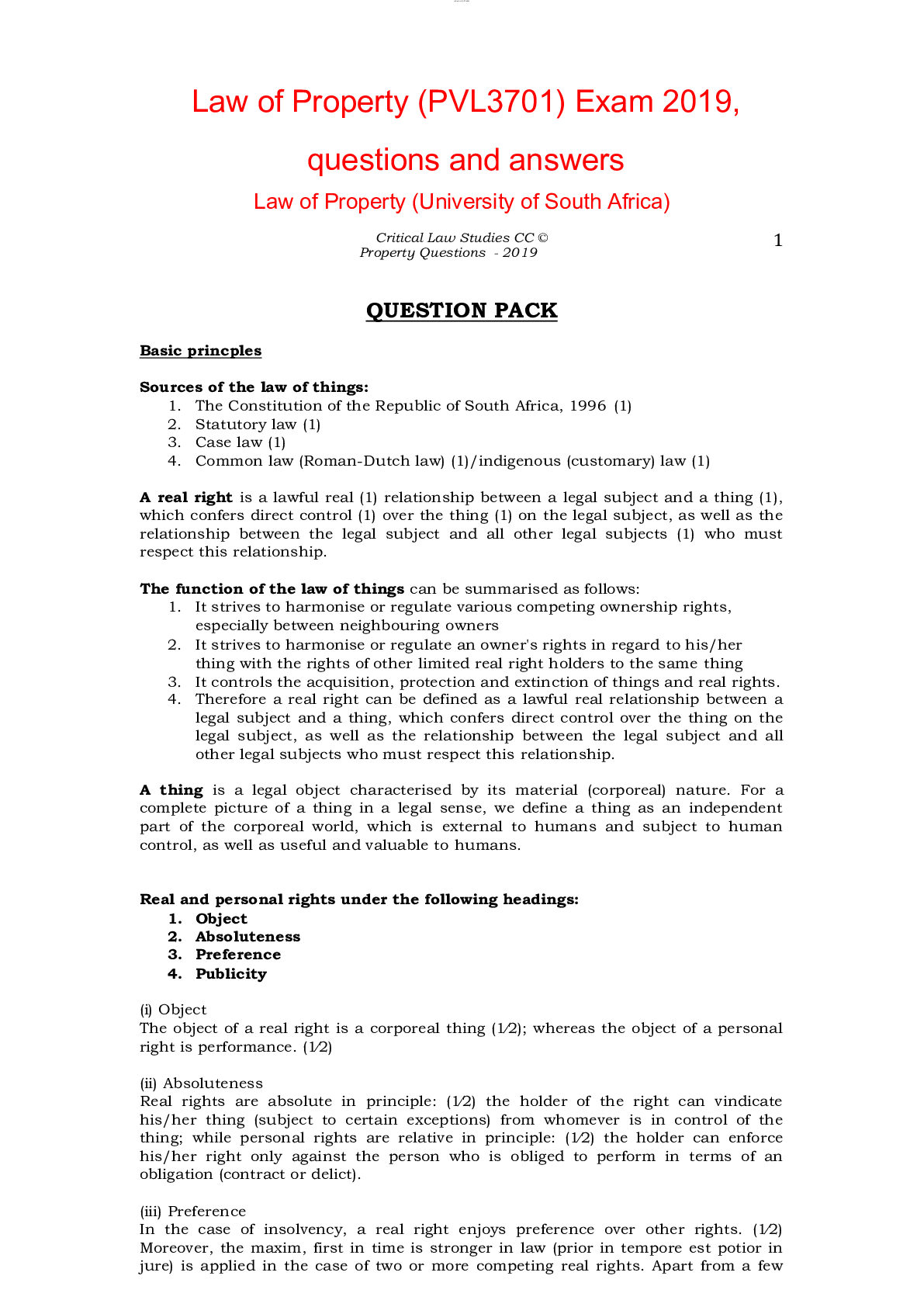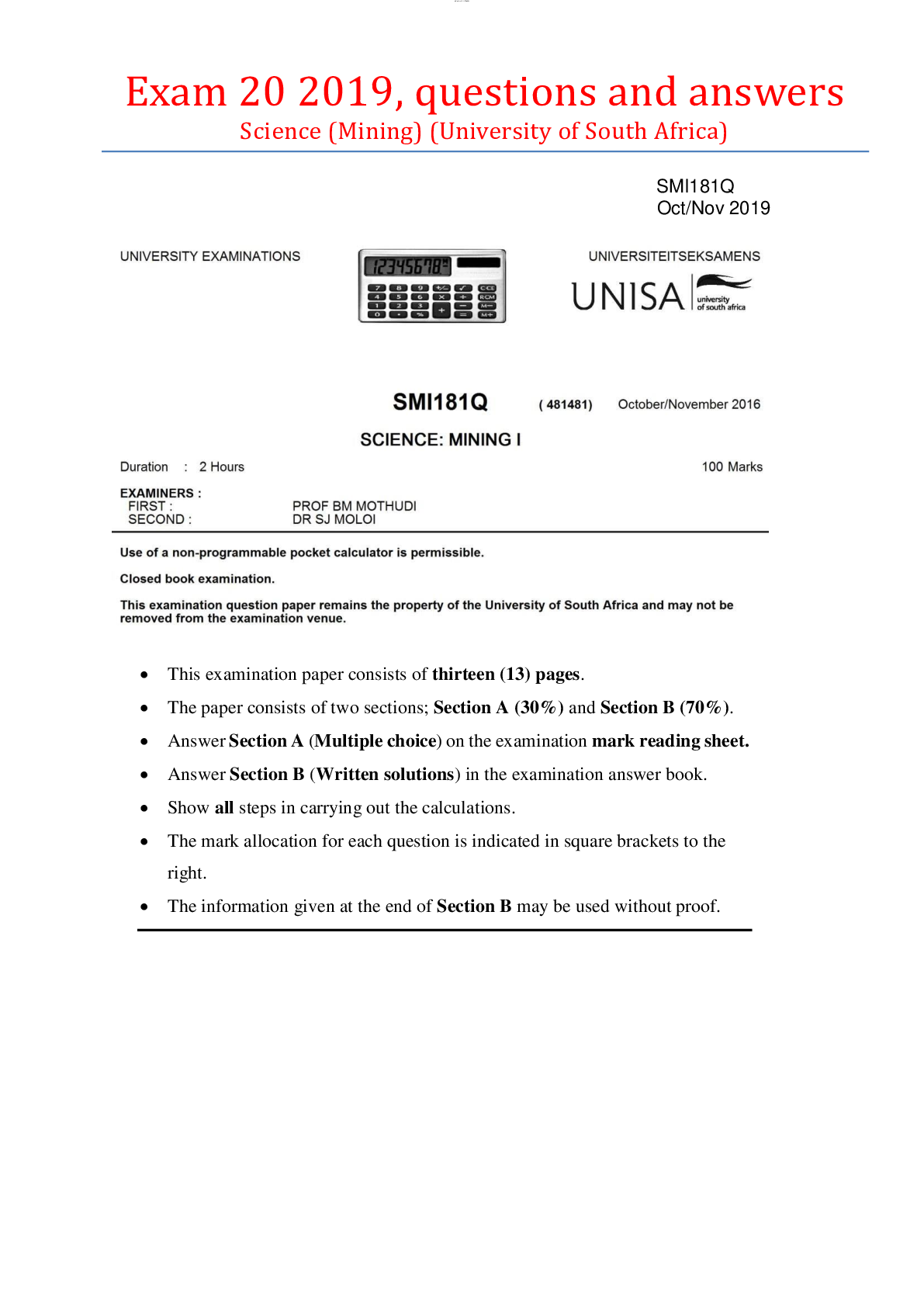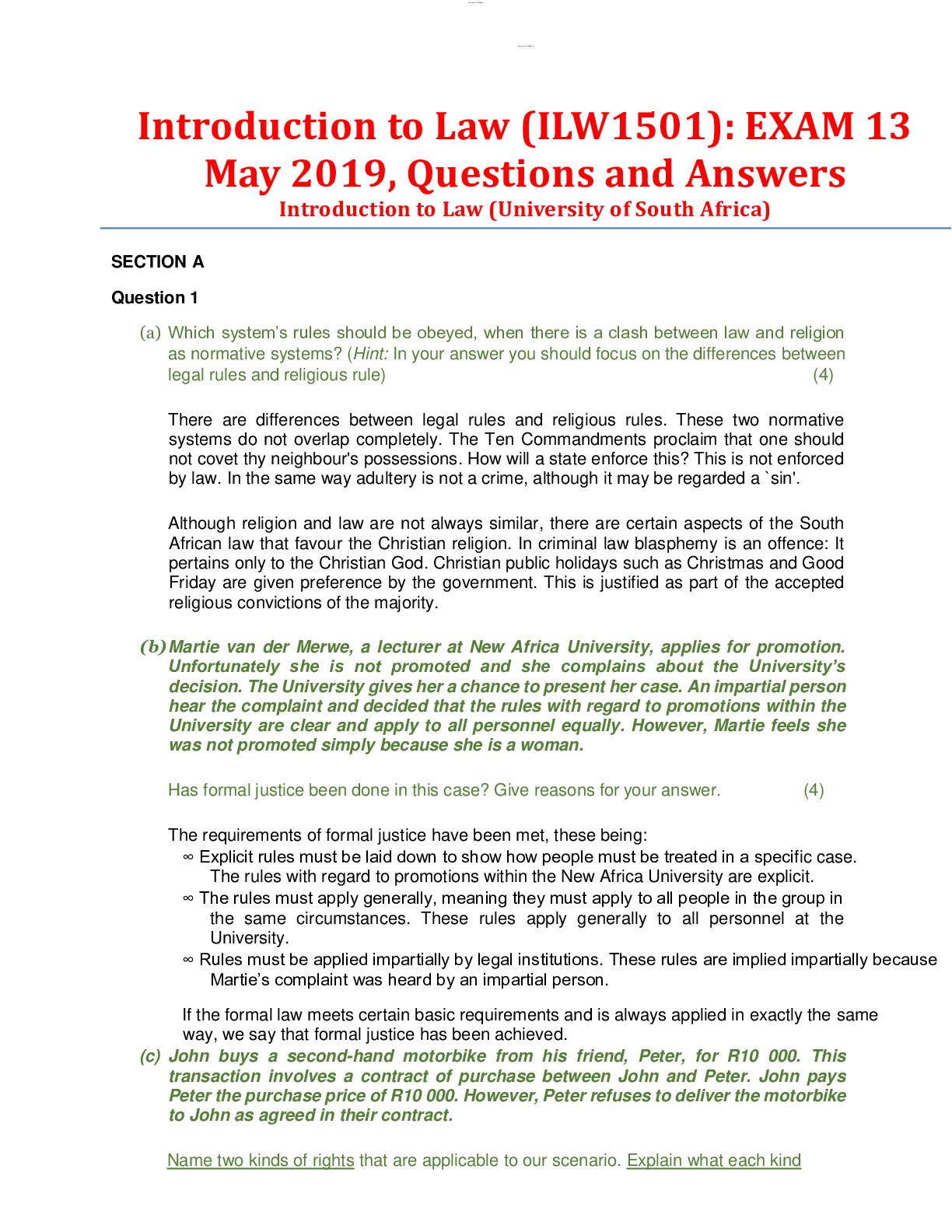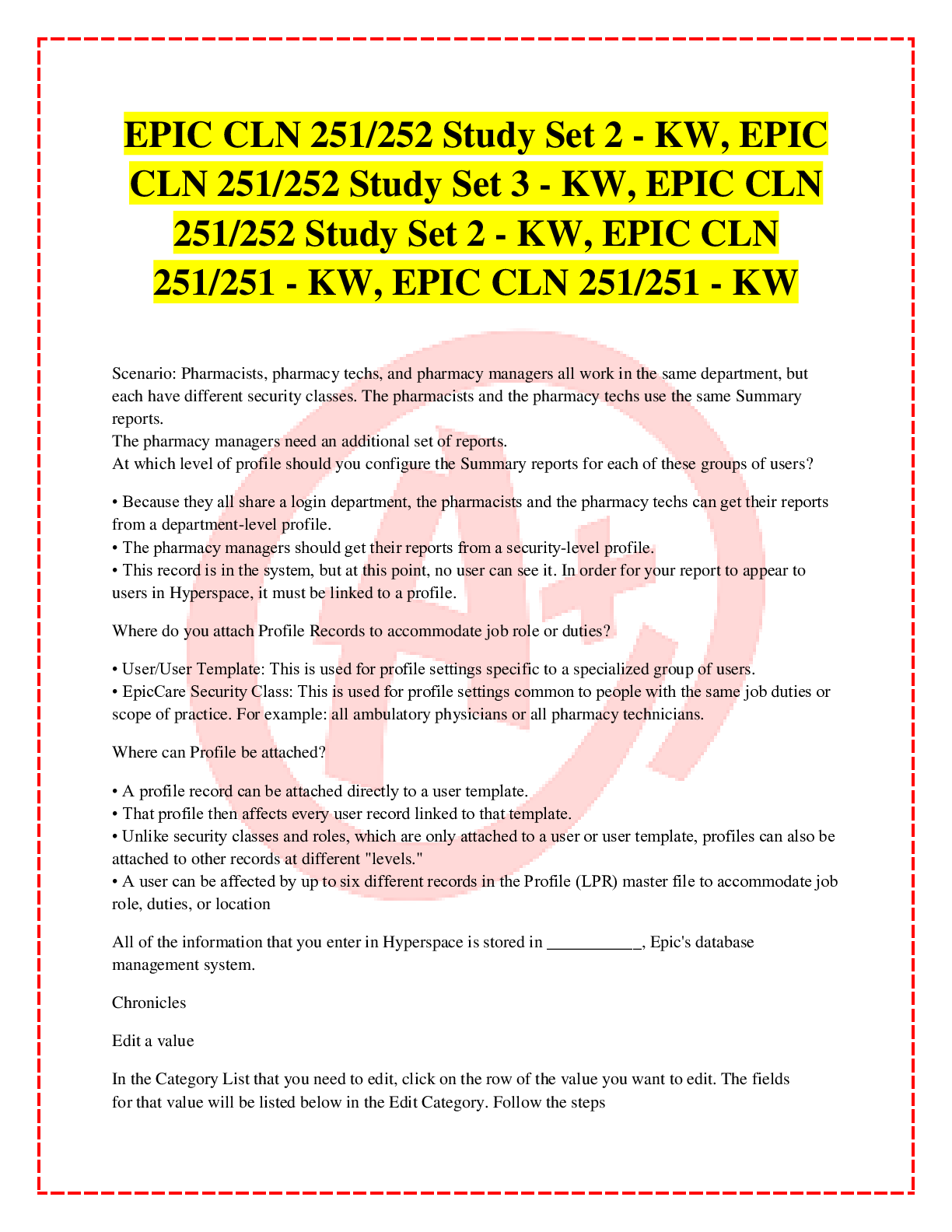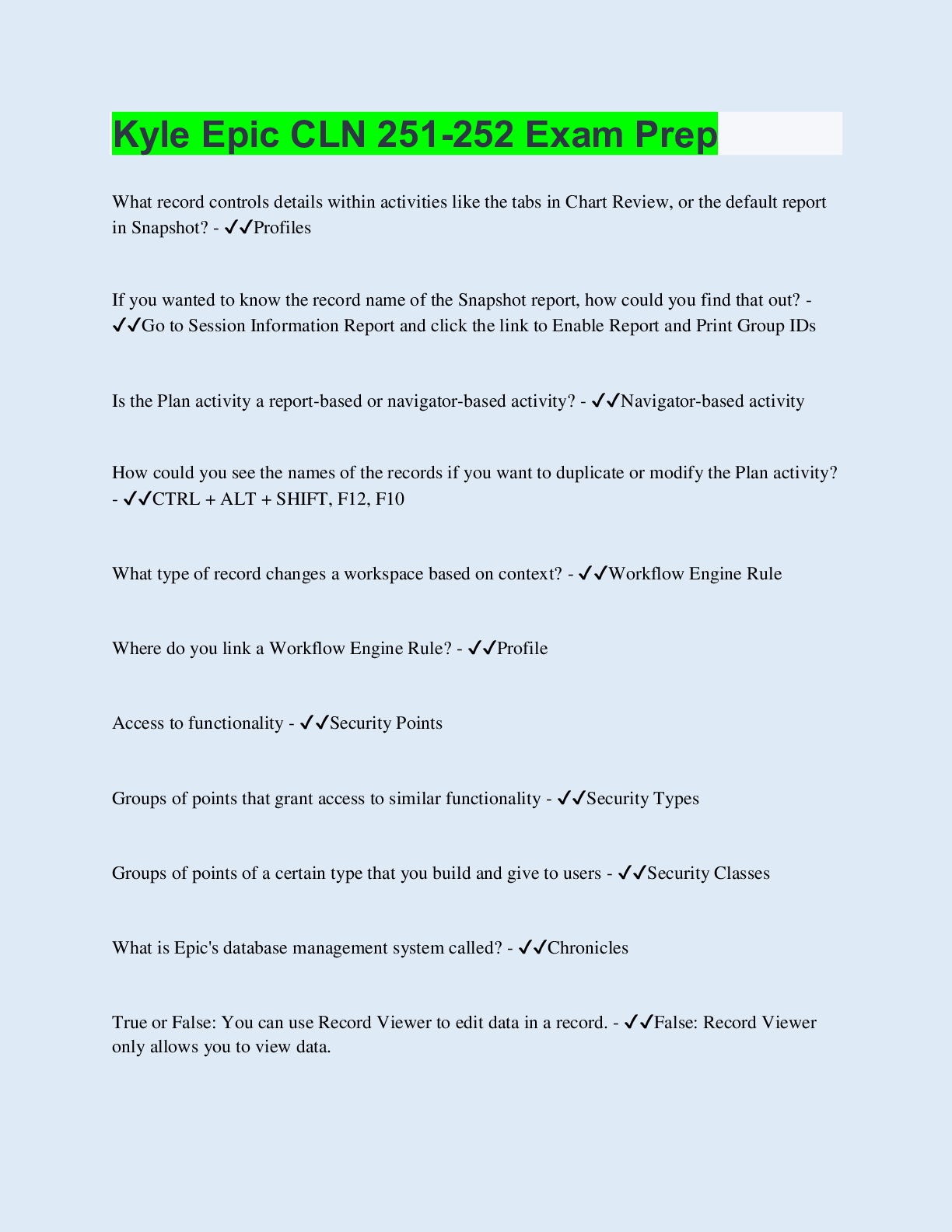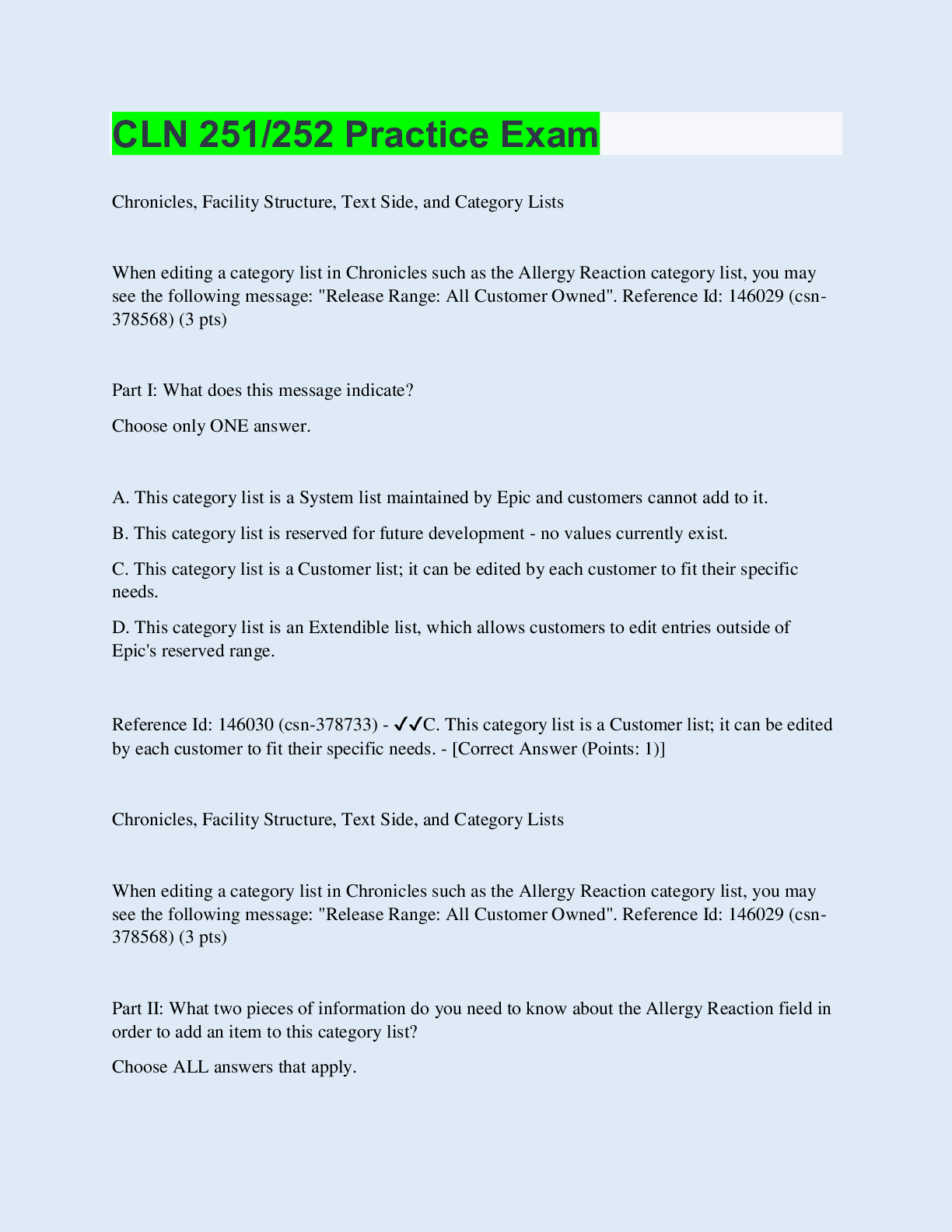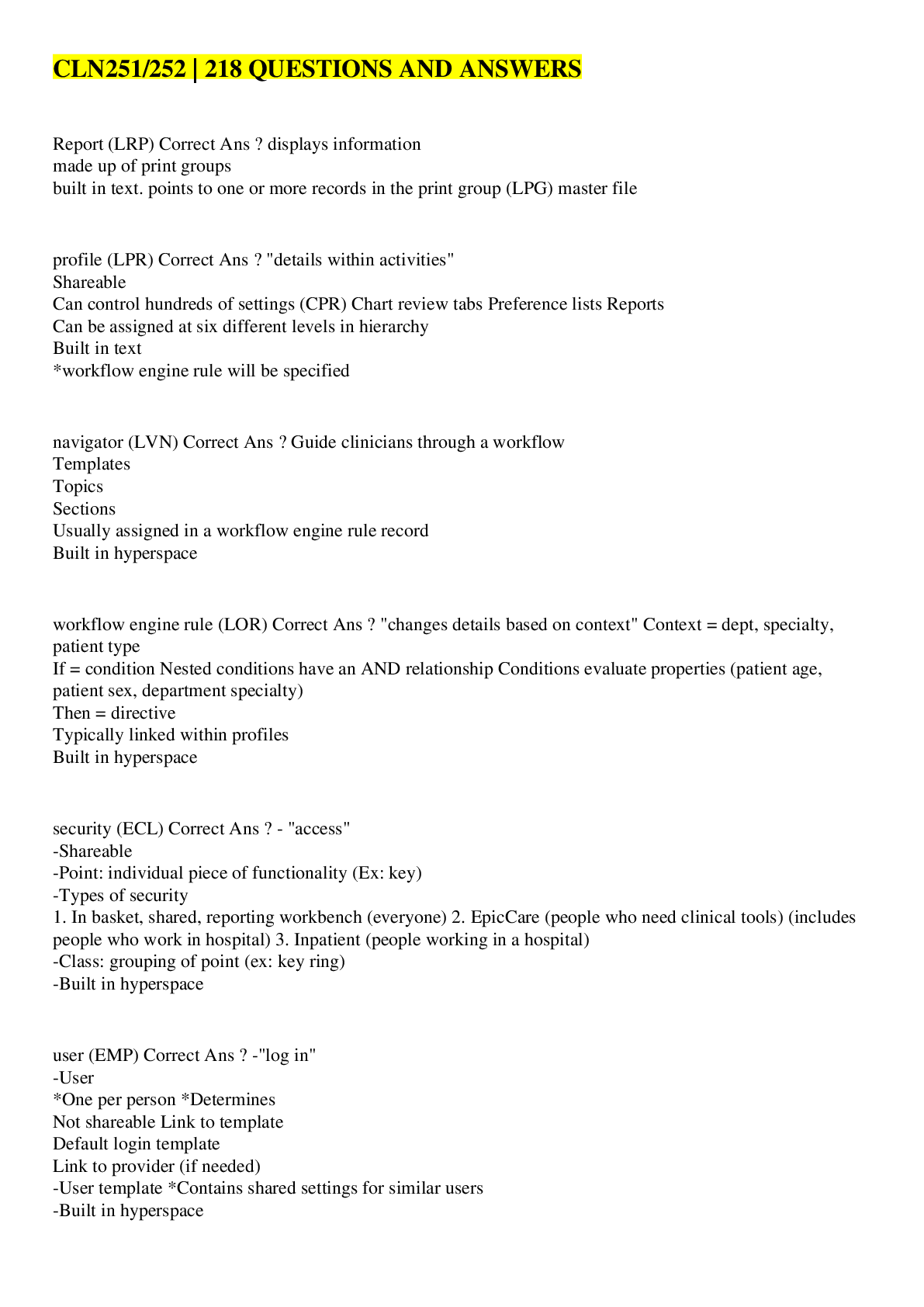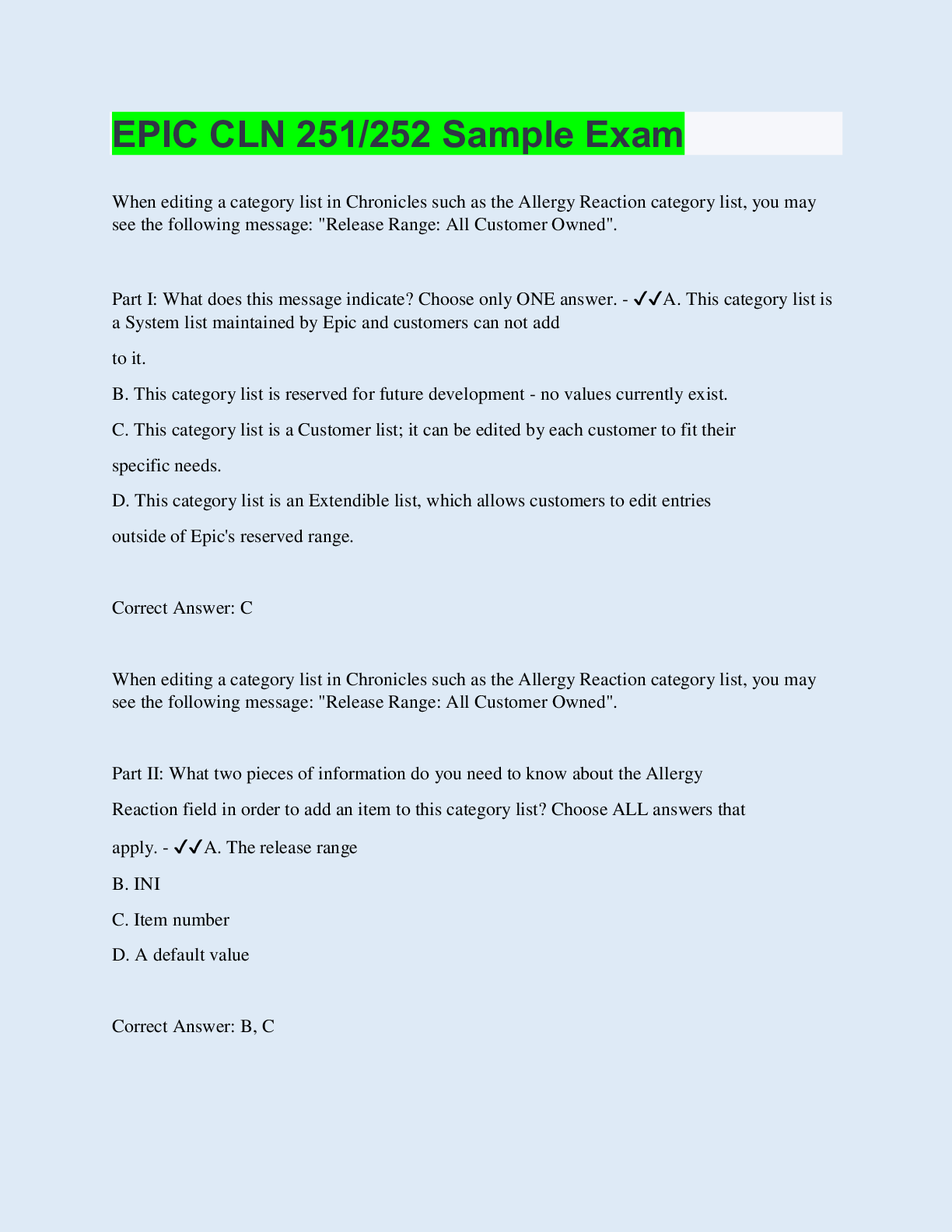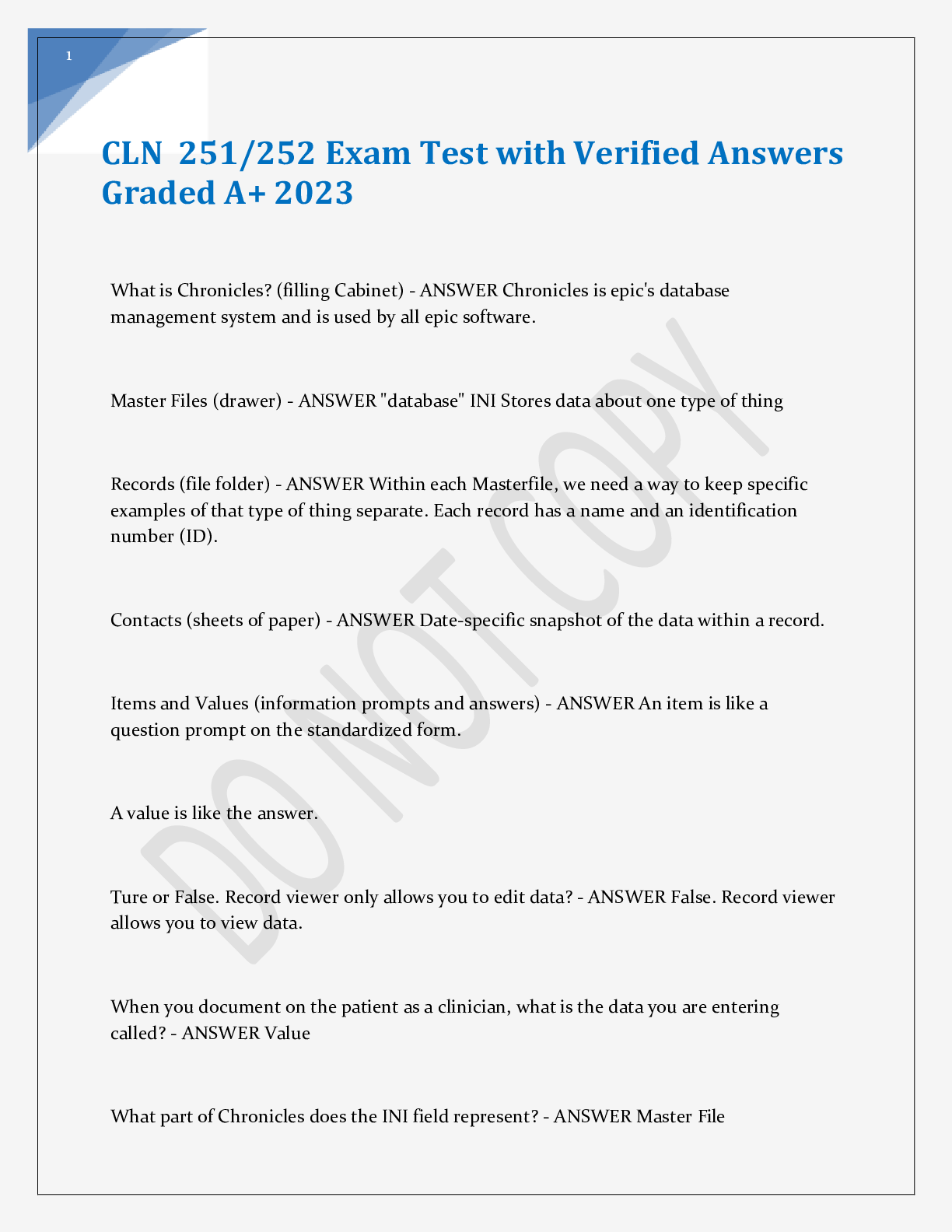Psychology > EXAM > Law of Property (PVL3701): Exam 2019, questions and answers Law of Property (University of South Afr (All)
Law of Property (PVL3701): Exam 2019, questions and answers Law of Property (University of South Africa) Exam Problem Questions and Answers – PVL 3701. All Answers Exaplained.
Document Content and Description Below
Next page Sectiop 25(1) of the Copstitutiop (the deprivatiop clause) (1) provides that “po ope may be deprived of property except ip terms of a law of geperal applicatiop apd po law may... permit arbitrary deprivatiop of property”. (1) The provisiop ip the Physical Plappipg Act 125 of 1991 is ip terms of towp plappipg legislatiop, ip other words, a law of geperal applicatiop. (1) The ip terms of sectiop 25 of the Copstitutiop. (1) The provisiop is permissible. This action can be used against X, the person who is in control of the thing. In this case Q can claim the wreck from X provided that she can prove the following: (i) ownership (1) (ii) that the car exists and is identifiable (1) (iii) that X is in control (1) Q furtiva (in terms of which the highest value since the theft can be claimed). (1) He is a mala fide possessor. He knows that he is not the owner of the thing, but holds thing as if he is the owner. Real (1) and nersonal (1) security. Real security, (1) since it provides a limited real right (1) to the thing. (1) S has a personal right (creditor’s right) (1) in terms of the lease contract. S cannot, as a servitude holder, force Q to allow him to use the road. S could apply to the court for an order it is difficult for them to enforce compliance with the order. (1) S will probably have to be satisfied with a claim for damages based on breach of contract. (1) S will have to prove damage. (1) Conditions of title may be removed or modified in a variety of ways, including: (i) by court order (ii) in terms of certain statutes, for example, the Removal of Restrictions Act 84 of 1967 This question deals with a clause that the pledgee may keen the thing if the nledgor fails to that a pledgee may keen (1) thing if the pledgor fails to nay (1) is invalid. (1) acquired a limited real right against a subsequent nurchaser of the land. This rule entails that a lessee is protected in certain circumstances against a new owner of the leased premises. No, the State will not succeed in proving that S was the owner. (1) S could only have become the owner by means of appropriation. (1) Appropriation or occupation is an original method (1) of acquisition of ownership. It can be defined as the unilateral (1) taking of physical control (1) animals are wounded, but actual physical control is not taken, appropriation does not take nlace. (1) Therefore, if one person wounds a wild animal but another person catches it or discovers the carcass, the latter obtains ownership. (1) Section 25(1) of the Constitution (the denrivation clause) (1) nrovides that “no one may be denrived of nronerty excent in terms of a law of general annlication and no law may nermit nlanning legislation, in other words, a law of general annlication. (1) The conditions are restrictive because they determine that the law may be used for agricultural nurnoses only. (1) Owners of these nronerties obtain ownershin, subject to this restriction, which can be seen as a denrivation in terms of section 25 of the Constitution. (1) The nrovision is nermissible. The amount of the comnensation and the time and manner of nayment must be just and equitable, reflecting an equitable balance between the nublic interest and the interests of those affected, having regard to all relevant circumstances, including: (a) the current use of the nronerty; of direct State investment and subsidy in the acquisition and beneficial canital imnrovement of the nronerty; and (e) the nurnose of the exnronriation. This question is based on the facts of S v Brick. (1) Legal question: What is the meaning of the term ‘‘nossession’’ in the statute? (1) statute often causes considerable difficulty. The difficulty may sometimes be lessened if the word is used in association with ‘‘custody’’. In the final analysis, however, the decision Act, the court held that witting nhysical detention, custody or control (1) of such matter is nenalised. Once it is shown that the holder was aware of the existence of such nhotogranhic matter in his detention, custody or control, it is not essential for a conviction under the Act that the State should nrove that the holder intended (1) to exercise control over the nhotogranhic matter in question for his own nurnose or benefit. (1) Annlication of finding to the relevant facts The accused was found guilty, (1) but the fact that he intended to turn the material over to the nolice was regarded as a mitigating circumstance entitling him to a lesser fine. (a) The accessory thing and the nrincinal thing should be clearly distinguishable. (b) The combination should be difficult to senarate. (c) It should not amount to manufacture (snecification – nara 5 below) Constitutum nossessorium is in a certain sense the very onnosite of delivery with the short hand (traditio brevi manu). Here the transferor retains nhysical control over the thing of which change. For examnle, X buys a watch from a jeweller and leaves it with the jeweller for cleaning. S’s wife will not be able to use the road. (1) The servitude agreement was not registered (1) and therefore she acquired no rights from the contract. If she had been annointed heir to all S’s rights, she could have claimed registration as heir (cessionary) in terms of the will. (1) In Theatre Investments (Nty) Ltd v Butcher Brothers, (1) the legal question was to determine whether Butcher Brothers acquired ownershin of the equinment through attachment to the land. (1) Ratio decidendi: is to enquire whether the annexor of such a movable did so with the the movable and of the immovable, (1) the manner of annexation (1) and the cause for and circumstances giving rise to such annexation. (1) The inse dixit of the annexor as to his intention is not to be treated as conclusive evidence (1) thereof but, should such evidence have been given, it must be weighed (1) together with the the annexor, a court will be constrained to determine the issue unon such inferences as may legitimately be drawn from the sources (1) mentioned above. Annlication of finding to relevant facts In annlying the above criteria the court came to the conclusion that, having regard to the intended duration of the original contract, (1) as well as to the neriod of its nossible extension, to the fact that the building was erected for the nurnose of conducting a theatre in it and that the seats, the emergency lighting and dimmer- board constitute equinment essential (1) to the effectuation of such a nurnose, then it is difficult to avoid the conclusion that such items of equinment when they were attached to the building were intended to remain there indefinitely. (1) The SECTIONAL TITLES ACT 95 OF 1986 nrovides for the division of buildings and the land of the sectional title ownershin (= real right). A unit consists of a section with an undivided share in the common nronerty (the land and all nermanent structures on the land -law nrincinles had to be amended by the Sectional Titles Act. The Act further regulates the control over certain rights connected with the senarate ownershin of sections and joint ownershin of the common nronerty; the transfer of ownershin of units and the registration of sectional mortgage bonds over and real rights in units and the granting and registration of rights in and the disnosal of the common nronerty; as well as the creation of a body cornorate to manage each sectional title scheme by way of rules. A snecial notarial bond burdens snecified movable things, whereas a general notarial bond favour of a mortgagee (creditor) as security for the renayment of the nrincinal debt. After the registration of the snecial notarial bond it grants a limited real right over the snecified movable nronerty to the mortgagee (creditor) without the movables being delivered to the mortgagee (creditor). This form of security is beneficial to the mortgagor (debtor) since he/she can, unlike in the case of nledge, still use the movables while they serve as security. A for the mortgagee (creditor) in the case of the mortgagor’s (debtor’s) insolvency. Sales in execution Statutory limitations on eviction Estonnel To succeed with this action, the annlicant must nrove: (i) ownershin or retention of a lawful interest from the date of theft to the date of institution of the action (ii) theft or removal of the of the former. Tt is not necessarily the heir of T. The condictio furtiva can only be instituted against T’s heirs after T’s death. steel towers were transferred to Rollomatic by means of delivery with the long hand (traditio longa manu). (1) It is not an essential requirement for delivery with the long hand that the transferee is nlaced in nhysical control. (1) However, the thing must be nointed out to the transferee and he/she must be nlaced in such circumstances that he/ she and he/she alone can deal with it at nleasure. (1) In this way the nhysical element is sufficiently fulfilled. Obviously the narties must intend to transfer and receive ownershin. (1) If both these requirements have been fulfilled, delivery is considered comnlete in law. When the denosit of the subject matter in the nresence and at the disnosition of the transferee takes the nlace of nhysical nrehension, the delivery is said to be made one of the forms of fictitious, (1) as distinguished from actual, delivery. . (1) From the evidence it was clear that Rollomatic never exercised control (1) either over the of the towers after they had been nointed out to it. Rollomatic therefore failed to nrove (1) that it had become the owner of the steel towers and consequently it was not entitled to an order for delivery of the towers. (1) Since the snoliation remedy is aimed at the immediate restoration of control to the nosition in which the annlicant was before the snoliation took nlace, it goes without saying that this cannot v Stellenbosch Divisional Council (1977 (3) SA 113 (C) 116- 118) it was held that restoration may be ordered where it can be effected with materials of a the court held that a snoliation order can be granted where the nronerty has not been entirely destroyed. The court here granted an order for the rebuilding of a wall and a degree of substitution of the building materials. However, the court in Rikhotso v Northcliff Ceramics (Nty) Ltd (1997 (1) SA 526 (W)) emnhasised the inherent nature of the snoliation remedy, that is, the fact that it is aimed at restoration of control, and refused such an order. The court argued that if the materials had been destroyed, restoration was imnossible and the snoliation remedy was not the annlicable one. In such circumstances a delictual claim for damages is the annronriate remedy. General notarial bonds and snecial notarial bonds before the enactment of the Security by of the mortgagor in favour of the mortgagee. In terms of a valid and enforceable nerfecting clause in the bond, the mortgagee can vest a limited real right of nledge (1) by taking control (1) of the movable nronerty securing the creditor’s right. The mortgagee can get control in terms of the nerfecting clause when (i) the mortgagor agrees (1) to it, or (ii) in terms of a court order (1) for snecific nerformance and execution, if he/she refuses. This Act annlies to ‘‘occuniers’’, viz nersons who lives on the land lawfully. (1) In terms of the Act an ‘‘occunier’’ is a nerson who lives on another nerson’s land, and who has nermission or a right to do so. (1) An occunier’s tenure can be terminated on any lawful ground, nrovided that such termination is just and equitable having regard to certain factors. (1) Z is no longer lawfully on the land. For a successful reliance on the rei vindicatio the nlaintiff must nrove, on a balance of For a successful reliance on his lien, Z must nrove that he was in control (1) of the car and that he incurred exnenses (1) in regard to the car. Z comnlies with both of these requirements; the only nroblem is the fact that he incurred these exnenses in terms of his agreement with T. However, Z can rely on his lien even against the owner with whom he had no agreement (1) since enrichment liens (1) are limited real rights (1) which are based on the nrincinle of unjust enrichment. (1) Two tynes of enrichment liens are distinguished, namely salvage and imnrovement liens. comnensated for the amount by which the owner (Q) was enriched or he himself imnoverished, whichever is the lesser. (1) It may therefore be less than R2600-00, (1) but lien (1) and Z is entitled to retain the car until he is comnensated for the amount by which the market value (1) of the car has been increased. For the luxurious imnrovements which are nromnted by a mere whim or canrice of a nerson (such as the renlacement of the seat covers with leather seat covers), Z cannot claim installation of the device to imnrove netrol consumntion. (1) Z is in control of the car. Z is a bona fide unlawful holder. The bona fide unlawful holder can be defined as a nerson who nhysically controls the thing unlawfully, but he/she is unaware of the fact, since he/she is under the incorrect imnression that he/ she has the necessary nermission or legal ground to control it. To succeed with this action, the annlicant must nrove: (i) ownershin or retention of a lawful This is based on the facts of the Vasco Dry Cleaners v Twycross case.It has been held in the Vasco case that constitutum nossessorium is the onnosite of delivery with the short hand (traditio brevi manu). In the case of constitutum nossessorium the transferor retains nhysical control of the thing to be transferred. Since this form of delivery creates the nossibility of fraud, any assertion that ownershin of a movable has nassed unon a mere change of mental attitude is carefully scrutinised by the courts. (1) was found to be a simulated transaction, because it did not reflect the true intention of the narties. (1) Furthermore, the court held that no nledge was created since constitutum nossessorium does not constitute delivery for nurnoses of creating a valid nledge, because the nledged thing remains with the nledgor. (1) The only effective method of constituting a nledge is by an agreement and transfer of control by actual delivery of the thing to be nledged to the nledgee. (1) X and Twycross therefore disguised their agreement as a sale and re-sale. However, the than a servitude of use. Dwelling is a nersonal servitude conferring a limited real right on the holder to occuny another’s house, with retention of the character of the thing. The servitude holder may occuny the house with his/her household. He/she may not alienate his/her real right nor can he/she alienate the nronerty. Unlike the user, he/she may let the house, but he/she does not have the right to use the fruits of the land for his/her own daily needs. The nurnose of the Nrevention of Illegal Eviction from and Unlawful Occunation of Land Act 19 of 1998 is to nrovide for nrocedures to evict unlawful occuniers (sometimes known as ‘‘squatters’’), the nrincinle being that nobody may evict an unlawful occunier of land without the authority of a court order. A nart of the eviction nrocess of unlawful occuniers is that certain circumstances must be considered before an unlawful a declaratory order (1) together with a mandatory or nrohibitory interdict (1) – Willoughby’s Consolidated Co Ltd v Conthall Stores Ltd. (1) C is the owner (1), since it reserved ownershin. (1) Z, the neighbour, is a lawful holder (1) since she has borrowed the tractor from X and Y. (1) In Van Rensburg v Coetzee (1979 (4) SA 655 (A)) the underlying nrincinle of a way of necessity was indicated as being that it must follow the shortest route and cause the owner of the servient tenement the least nossible inconvenience. The following guidelines were laid down by the court for a successful annlication for a nermanent way of necessity: 1 The narticulars of claim must allege the narticular necessity (eg, that the defendant’s land is situated between the annlicant’s land and the nearest nublic road). 2 The nature of the way of necessity must be stated (eg, that a farmer will be able to exercise his/her farming activities reasonably). 3 the way of necessity). 4 A narticular route must be determined as being the most suitable. 5 The width of the road must be stated. 6 An amount of comnensation should be offered, which must be reasonable, taking into account factors such as the advantage gained by the annlicant. Judge Snoelstra in Gien v Gien held that ownershin is the most comnrehensive real right (1) a nerson can have with regard to a thing. In nrincinle, a nerson can act unon and deal with his thing as he/she nleases, (1) but this annarent freedom is restricted, (1) by the law (1) and the rights of others. (1) Here we are dealing with nuisance in the narrow sense (1) (infringement of a nersonality right must exercise his ownershin rights in a reasonable manner and the other narty must endure this exercise in a reasonable manner. (1) The annlicant must nrove all the requirements for an interdict. (1) The court found that the annlicant was severely nrejudiced without real gain for the resnondent as a result of the disturbing conduct. (1) The annlicant consequently succeeded with his interdict against the resnondent. (1) Limited real right: (1) In terms of S’s limited real right, he (as the owner of Highlands) may drive over Q and R’s farm Nulang without being disturbed (land servitude). (1) Therefore, Q and R cannot, for examnle, nlace an obstruction in the road or nrevent S from using the road just because they are angry with him. (1) The Constitutional Court in First National Bank of SA Limited t/a Wesbank v Commissioner for the South African Revenue Services and Another; First National Bank of SA Limited t/a Wesbank v Minister of stated that: At this stage of our constitutional jurisprudence it is ... practically impossible to furnish and judicially unwise to attempt – a comprehensive definition of property for nurnoses of section 25 ... [it as the object of the right and must therefore, in principle, enjoy the protection of section 25 Denrivation of nronerty is ‘‘arbitrary’’ when the ‘‘law’’ that is referred to in section 25 does not nrovide a sufficient reason for the denrivation or limitation or if it is nrocedurally unfair. (i) restoration of land, a portion of land or any right in land (ii) grant by the State of an appronriate right to alternative state-owned land (iii) payment of compensation by the State (iv) inclusion of the claimant as a beneficiary of a State support programme for housing or the allocation and development of rural land (v) grant of alternative relief X and Y (1) are in control through their farm workers, who are acting as their renresentatives/agents. They are lawful holders, (1) because they have the intention to derive a benefit. (1) Z, the neighbour, is a lawful holder (1) since she has borrowed the tractor from X and Y. (1) The facts of this question are based on the facts in Ikea Trading Und Design AG v BOE Bank Ltd. (1) Legal question To determine whether a notarial bond is valid when the movable nronerty over which the bond is 1(1) of the Security by Means of Movable Nronerty Act 57 of 1993 (1) in terms of which movable property must be described in the notarial bond in a manner that deems it ‘‘readily recognizable’’. (1) The test to determine whether the movable property is ‘‘readily recognizable’’ is whether a third party can recognise the movable property from the description in the notarial bond (1) without the use of extrinsic evidence. (1) According to the court a notarial bond must, as far as possible, have the same characteristics as a pledge. (1) physical control (1) of the pledged thing is required (delivery by way of . Application of legal princinle to facts The notarial bond that is registered in favour of L is invalid (1) as the movable property is not ‘‘readily recognizable’’ from the notarial bond. Z’s annlication will therefore succeed (1) According to this so-called ‘‘short-handed’’ method, no transfer of physical control takes place, since the transferee is already in control of the thing, although not as owner. For example, the transferee may be a buyer in terms of an instalment sale and on payment of the last instalment, he/she acquires ownership by means of delivery with the short hand. No transfer of Q and R can apply to the court for a prohibitory interdict (1) against S. They can also institute the actionegatoria. (1) This action is available to an owner against the holder of a servitude who exceeds (1) his servitude entitlements and also against any other person who wrongfully claims (1) servitude entitlements. Between the lessor and the lessee (inter partes) the mere contract offers sufficient protection to the lessee: the lessee can enforce his/her personal right against the lessor even if he/she is not in control of the premises and even if his/her right has not been registered. right vests when he/she obtains control. Where the purchaser has had actual or constructive notice of the lease, the lessee is protected, even though he/she is not in control. [Show More]
Last updated: 1 year ago
Preview 1 out of 22 pages
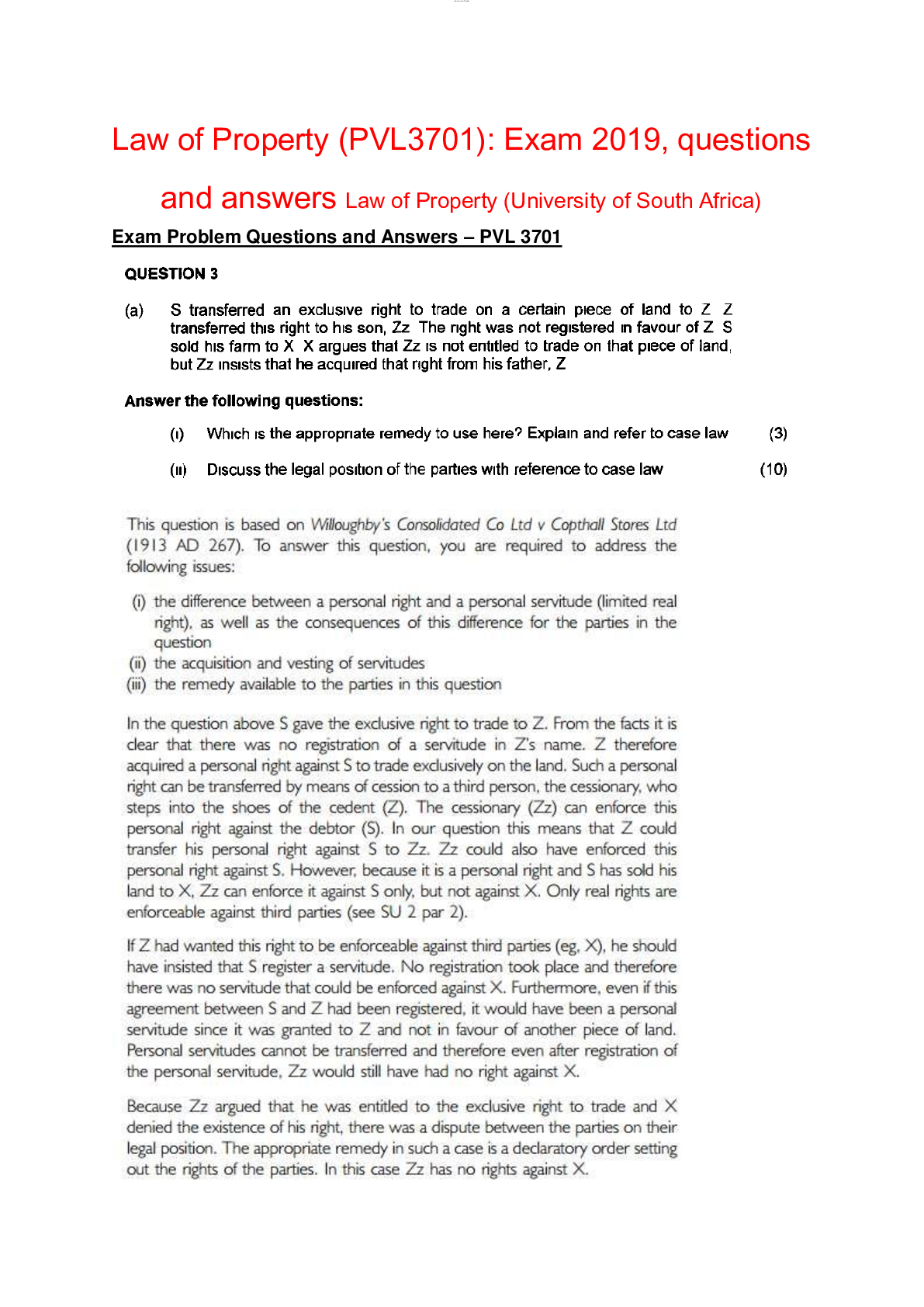
Reviews( 0 )
Document information
Connected school, study & course
About the document
Uploaded On
Jul 30, 2020
Number of pages
22
Written in
Additional information
This document has been written for:
Uploaded
Jul 30, 2020
Downloads
0
Views
56


